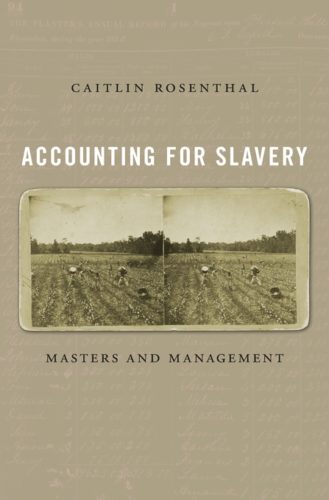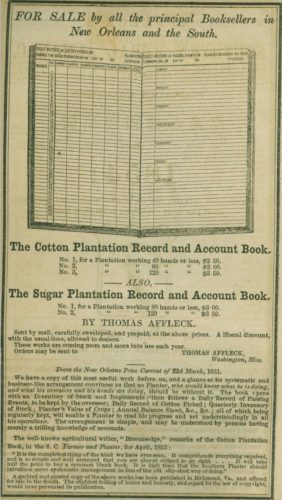Book Review: “Accounting for Slavery” — Plantation Roots of Scientific Management
By Jeremy Ray Jewell
In this valuable study, Caitlin Rosenthal isolates an assortment of business practices and technologies that reflect the sophistication of New World plantation economies — dispelling myths of their romantic crudeness.
Accounting for Slavery: Masters and Management by Caitlin Rosenthal. Harvard University Press, 312 pages, $35.

We have been, and continue to be, haunted by the relationship between slavery and capitalism in the early Atlantic world. How we understand their interconnections reflects the ideological and psycho-social needs of the period. Some analysts try to see the arrangement as a regressive hangover from the pre-modern era, or rationalize it as an intermediary state in the development of mercantilism.
The dissatisfaction with those explanations is driven by an obvious discomfort among many scholars. Slavery was generally immensely profitable and admirably efficient. And that suggests that slavery was never directly at economic odds with capitalism. In fact, it could be seen as not so much a logical step to the establishment of ‘free’ labor, but as an equivalent and competing viable system. The notion that coerced labor could be profitable also raises disturbing historical questions; for example, it challenges Cold War faith in the values of polarized systems in the US and USSR. It also undercuts the ‘Lost Cause’ notion of an antebellum South gallantly resisting the march of the Northern nation of shopkeepers and pragmatic business management practices, a South too steeped in tradition and pageantry to recognize the death knell of its economically inferior (but allegedly “humanistic”) paternalism.
In revolutions, everyone is compelled to invest in an imagined break with the past. Despite the reassuring rhetoric from all sides, the end of slavery has been no different. Everyone along the ideological divide has projected a self-protective divide in time. Partisans of all shades insist that the abolition of slavery meant radical severance — they resist arguments that find continuities, that insist, as William Faulkner puts it, the past is never really past.
Caitlin Rosenthal’s valuable work Accounting for Slavery asserts continuities, exploring strong connections between plantation management practices and the theory of “scientific management,” also known as “Taylorism” (after its creator Frederick Winslow Taylor). Rosenthal explores the various ways in which the New World slave labor economies coincided with — and contributed to the growth of — productivity management practices, laying the groundwork for Taylorism and its influence in operations management and industrial engineering that continues today. Along the way, this work challenges the mainstream beliefs that free markets and free labor depend on broader forms of democratic or personal freedom. Rosenthal is a business historian, and she is precise in her analysis, never framing her research as a harangue or polemic against capitalism or business. Nor does she risk overstating the associations between business management history and the slave labor economy. Fortunately, she lets the facts speak for themselves. She isolates an assortment of business practices and technologies that reflect the sophistication of New World plantation economies — dispelling myths of their romantic crudeness.
Significantly, slave owners made use of double-entry bookkeeping. They kept dual records, with corresponding and opposite entries. They also referred to standardized labor units (“fractional hands” for a laborer’s value, “task acres” for a spatial value of productivity). This system allowed for complex comparisons and productivity analysis. Although the value of a “hand” of labor was certainly less-than-scientific, it could take on more concrete definition through comparisons and exchanges of slaves among planters. The depreciation of the value of a slave could be calculated, a practice that Rosenthal reminds us is “widely regarded as a landmark in the advancement of management practices.” Depreciation was a significant factor in the slave economy; the enslaved became well acquainted with how a person could be devalued: anything from illness to running away. Such valuations of the person became the basis for slave mortgages and insurance policies, which were serviced by their own corresponding industries, and were deeply integrated into plantation life.
 In ways that sound familiar to most workers today, plantations developed complex systems of reward and punishment that were designed to deduce the productivity potential of an enslaved laborer. Incentives were used to increase output for a period; the results were used as evidence for future expectations of sustained high output. In a reaction familiar to workers today, enslaved laborers ‘wised-up’ to these management games would engage in “sogering” — stealth resistance methods designed to sabotage productivity.
In ways that sound familiar to most workers today, plantations developed complex systems of reward and punishment that were designed to deduce the productivity potential of an enslaved laborer. Incentives were used to increase output for a period; the results were used as evidence for future expectations of sustained high output. In a reaction familiar to workers today, enslaved laborers ‘wised-up’ to these management games would engage in “sogering” — stealth resistance methods designed to sabotage productivity.
Rosenthal proves that precise calculation of labor productivity took root in the slave economy. The irony is that it was more aggressively calculated there than among many Northern manufacturers of the time. Preprinted forms for slave plantation accounting flourished. Some were specifically designed for cotton or sugar plantations and rivaled Northern account books in their minimalism — after all, the lack of labor negotiations and turnover meant fewer empty rows and columns. When it comes to the institution of slavery, the power asserted by how labor was managed is often overlooked. Yes, New World slavery relied on all of the horrors we ought to be familiar with: the brutality, terror, cruelty, and sadistic capriciousness. But the institution would never have been as economically viable as it was without effective management. Technological developments alone would not have sustained the growing slave economy (and growing it was). As Rosenthal explains, new cotton strains could have increased the maximum possible yield, but would not in themselves increase the amount of work done. Similarly, violence could hasten the speed of labor — but could not overcome physical limitations. What really made the slave economy profitable was productivity analysis and management practices. As the 1800s progressed, these would become increasingly important.
As absentee landlordism increased in the British West Indies, more managerial decisions were made at greater distances from enslaved labor. A number of these West Indian planters ended up moving their entire operations to the American South following the British abolition of slavery in 1833. This made the South a powerhouse supported by slave wealth. On the one hand, the North placed it on the defensive. But, on the other, it had the means to go on the offensive in its attempts to dominate the American government as well as to push the borders of the slave economy increasingly southward (think of the Mexican-American War). In the 60 years prior to the American Civil War, the profitability of slavery was drastically expanding. Rosenthal quotes from Abraham Lincoln’s March 5, 1860 speech in Hartford, CT on this point. It is worth considering today, amid talk of the influence of money in politics:
The entire value of the slave population of the United States is, at a moderate estimate, not less than $2,000,000,000. This amount of property has a vast influence upon the minds of those who own it. The same amount of property owned by Northern men has the same influence upon their minds. […] Public opinion is formed relative to a property basis. Therefore, the slaveholders battle any policy which depreciates their slaves as property. What increases the value of this property, they favor.
Mythologies about slavery’s alleged ‘inefficiency’ and ‘non-profitability’ have dominated national and sectional dialogues since the end of the Civil War. The reasons behind maintaining this fiction are varied: expose some elemental sin that doomed the institution; divorce slavery from the liberal values of free markets and free labor; lament the passing of a civilization conceived of us idyllically pre-industrialist. All of these myths have one thing in common: they put slave labor on one side and free labor on the other and present them to us via a before-and-after picture. On one side, the vanished age of barbarism. On the other, the splendid foundation of capitalism — nothing but progress.
Perhaps the two sides of the picture have more in common than we would like to think. Yes, it is a bit too easy to draw analogies between an absentee plantation landlord and a modern board of directors. But outdated analogies don’t curb the cold, hard pragmatism of their effective — and shared — management practices. Management’s lack of proximity to its workers (reflected in its transformation of them into abstractions on ledgers) is a direct link between slavery and today’s global capitalist practices. Changing that arrangement would inevitably mean depreciating assets considerably. This equation is as true for Dhaka, Bangladesh in 2013 as it was for Valdosta, Georgia in 1853. On an elementary level, management’s distance from labor becomes a function of net asset value. Slavery in America showed how efficient and profitable this arrangement could be.
Jeremy Ray Jewell is from Jacksonville, Florida. He has an MA in History of Ideas from Birkbeck College, University of London, and a BA in Philosophy from the University of Massachusetts Boston. He maintains a blog of his writings entitled That’s Not Southern Gothic.
Tagged: Accounting for Slavery, Caitlin Rosenthal, Harvard University Press
